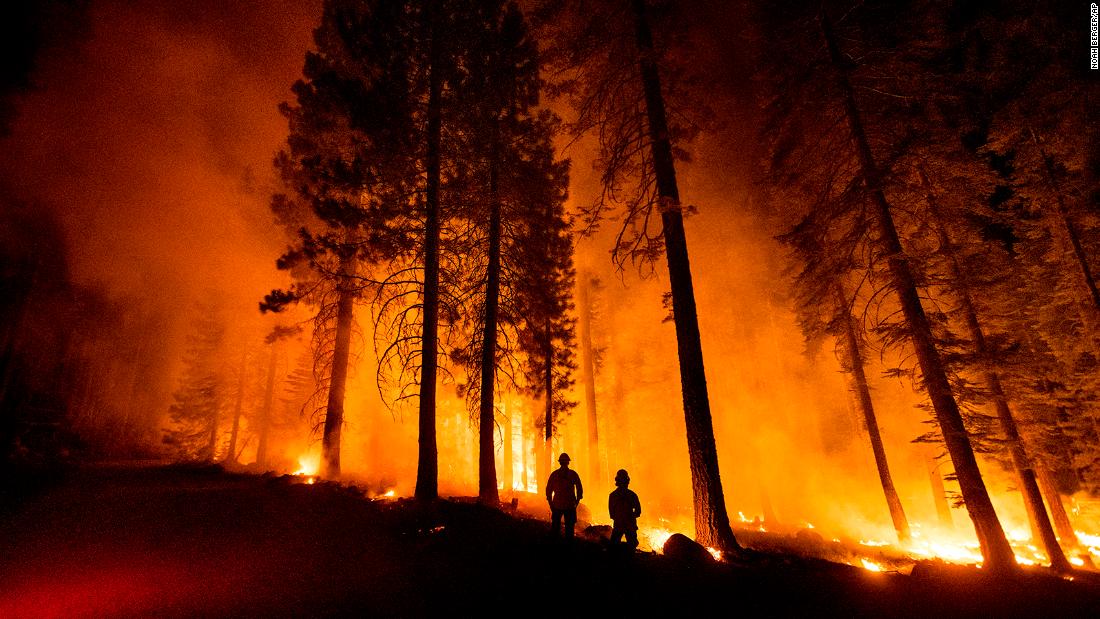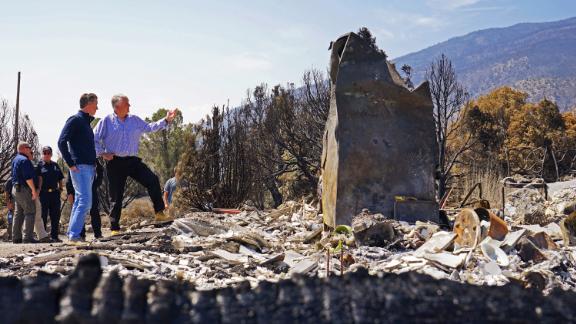First on CNN: President Biden to meet with 7 governors Friday to discuss devastating wildfires

Noah Berger/AP
Cal Fire captains Derek Leong, right, and Tristan Gale watch as crews try to stop the Dixie Fire from spreading. (AP Photo/Noah Berger)
CNN —
President Joe Biden and Vice President Kamala Harris will meet with seven governors on Friday to talk about how states are responding to a devastating Western wildfire season – and how the federal government can assist.
According to exclusive details shared with CNN, the virtual meeting will last an hour with governors whose states are experiencing wildfires and drought: Govs. Greg Gianforte of Montana, Jay Inslee of Washington, Gavin Newsom of California, Brad Little of Idaho, Kate Brown of Oregon, Tim Walz of Minnesota and Mark Gordon of Wyoming.
Biden and Harris will discuss efforts to strengthen wildfire prevention, preparedness, mitigation and response efforts, and will hear how an early and severe wildfire season is impacting residents and land in the states.
The group is also expected to discuss funding and investing in wildland firefighters, including increasing pay for federal firefighters who are battling blazes, and extending hiring for temporary firefighters. In June, Biden signed an executive order that raised the minimum wage for federal firefighters to $15 an hour.
The White House on Friday will also announce two new interagency working groups pointed at the impact wildfires and extreme heat. Biden’s National Climate Task force, which is chaired by National Climate Advisor Gina McCarthy, will announce a Wildfire Resilience Interagency Working Group, and an Extreme Heat Interagency Working Group.
The Wildfire Resilience Interagency Group will be chaired by US Department of Agriculture Secretary Tom Vilsack and Secretary of the Interior Deb Haaland, while the Extreme Heat Interagency Working Group will be chaired by Health and Human Services Secretary Xavier Becerra, National Oceanic and Atmospheric Administration Administrator Dr. Richard Spinrad, and Environmental Protection Agency Administrator Michael Regan.
There are 82 large fires burning in the West this week. Around 3.4 million acres have been burned in wildfires so far this year.
After touring the destruction caused by the Tamarack Fire, Nevada Gov. Steve Sisolak and Newsom pleaded Wednesday for more federal resources.
“We need help,” Sisolak said. “We need help on the federal side. We need more people coming in. We need more resources we need more air support. We need more people and more boots on the ground in order to make this more fair fight in terms of fighting these fires.”
The Tamarack Fire has charred more than 68,000 acres in California and Nevada, just south of Lake Tahoe, since igniting on July 4. Nearly 30 structures, including homes, have been destroyed or damaged, and at least one firefighter suffered first and second-degree burns while battling the blaze.
Calling the pay for federal forest workers “deplorable,” Newsom said Wednesday the US Forest Service needs more resources.
“At the end of the day US Forest Service is understaffed and under-resourced and has been for years and years and years,” he said.
CNN reported in June that federal hotshots were leaving the service primarily because of low wages. First-year federal hotshots make $13.50 an hour, according to David Alicea, vice president of the Forest Service Union in California.
“Yes, you can make overtime, but we’re putting them through the meat grinder,” Alicea told CNN. “We’re abusing them because we are short-staffed, and they are not getting their rest periods. They get laid off when fire season is over, and they choose not to come back.”
The President held a similar meeting with governors in late June as an unprecedented heat wave primed the Northwest for extreme wildfires.
“Climate change is driving the dangerous confluence of extreme heat and prolonged drought. We’re seeing wildfires of greater intensity that move with more speed and last well beyond traditional months, traditional months of the fire season,” Biden said in June.
CNN’s Paul Vercammen contributed to this report.
![]()




